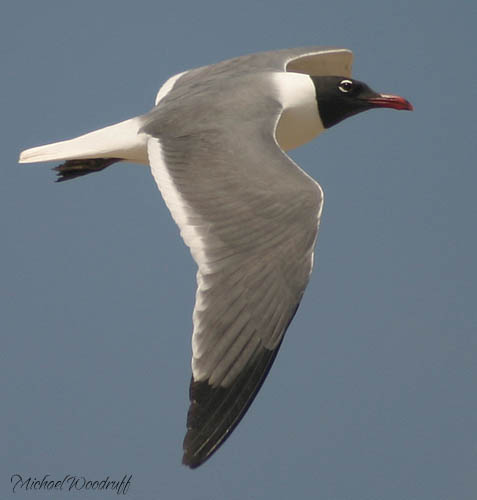|
|
| Line 1: |
Line 1: |
| | + | [[category:incomplete]] |
| | ;Larus atricilla | | ;Larus atricilla |
| | [[Image:Laughing_Gull.jpg|thumb|550px|right|Photo by Michael Woodruff<br/>Location: Brownsville Sanitary Landfill in South Texas, USA]] | | [[Image:Laughing_Gull.jpg|thumb|550px|right|Photo by Michael Woodruff<br/>Location: Brownsville Sanitary Landfill in South Texas, USA]] |
| Line 5: |
Line 6: |
| | | | |
| | ==Identification== | | ==Identification== |
| − | The Laughing Gull, Larus atricilla, is a medium-sized gull of North and South America. It breeds on the Atlantic coast of North America, the Caribbean, southern California, USA, and northern South America. Northernmost populations migrate further south in winter, and this species occurs as a rare vagrant to western Europe, although there was a large influx into North-west Europe in late October 2005 when there was a minimum of 18 (and anywhere up to a possibly maximum of 35) individuals on one day in the UK alone. The Laughing Gull's English name is derived from its raucous kee-agh call, which sounds like a high pitched laugh "ha... ha... ha...".
| |
| | | | |
| − | This species is easy to identify. It is 36-41 cm long with a 98-110 cm wingspan. The summer adult's body is white apart from the dark grey back and wings and black head. Its wings are much darker grey than all other gulls of similar size except the smaller Franklin's Gull, and they have black tips without the white crescent shown by Franklin's. The bill is long and red. The black hood is mostly lost in winter.
| + | 36-41 cm, 98-110 cm wingspan. White, dark grey back and wings and black head. Long red bill. Hood lost in winter. |
| | | | |
| − | Laughing Gulls take three years to reach adult plumage. Immature birds are always darker than most similar sized gulls other than Franklin's. First year birds are greyer below and have paler heads than first year Franklin's, and second years can be distinguished on the wing pattern and structure.
| |
| − |
| |
| − | Laughing Gulls breed in coastal marshes and ponds in large colonies. The large nest, made largely from grasses, is constructed on the ground. The 3 or 4 greenish eggs are incubated for about three weeks. These are omnivores like most Larus gulls, and they will scavenge as well as seeking suitable small prey.
| |
| | | | |
| | ==Distribution== | | ==Distribution== |
| − | Breeds on the east coast of North America from Florida north to Nova Scotia, disperses from breeding areas July-August and begins to move south in mid-August. Winters from North Carolina southwards, returning north in mid-March to mid-May.
| + | [[North America]] |
| − | | |
| − | Vagrant to many Western Palearctic countries including Iceland and the British Isles, France, the Netherlands and Scandinavia, Poland, Germany and Austria, Greece, Iberia, Morocco, the Canaries and Azores. The majority occur in Britain (c.96 records), recorded in all months and scattered throughout the country, lacking the strong south-westerly bias seen with most Nearctic vagrants. Records include many long-staying, wandering and returning individuals and one German record involved a bird displaying in a Black-headed Gull colony.
| |
| | ==Taxonomy== | | ==Taxonomy== |
| | ==Habitat== | | ==Habitat== |
| − | Breeds on low, flat coastal islands, saltmarshes and sand-dunes. Out of the breeding season mainly coastal on sandy beaches and estuaries, sometimes inland and follows the plough. Also follows ships and sometimes seen far out to sea.
| + | Coastal islands, saltmarshes and sand-dunes. |
| | ==Behaviour== | | ==Behaviour== |
| | + | A large nest is built of grass and placed on the ground. 3-4 greenish eggs are laid and incubated for about 21 days. |
| | + | |
| | + | They are scavengers as well as hunting small prey. |
| | ==External Links== | | ==External Links== |
| | {{GSearch|Larus+atricilla}} | | {{GSearch|Larus+atricilla}} |
| | *[http://www.orientalbirdimages.org/birdimages.php?action=birdspecies&Bird_ID=2713&Bird_Image_ID=916&Bird_Family_ID=104 View more images of this species on Orientalbirdimages] | | *[http://www.orientalbirdimages.org/birdimages.php?action=birdspecies&Bird_ID=2713&Bird_Image_ID=916&Bird_Family_ID=104 View more images of this species on Orientalbirdimages] |
| | [[Category:Birds]] | | [[Category:Birds]] |
- Larus atricilla

Photo by Michael Woodruff
Location: Brownsville Sanitary Landfill in South Texas, USA

Photo by bobsofpa
Nonbreeding plumage photographed at: Fort DeSoto Park, FL, USA
Identification
36-41 cm, 98-110 cm wingspan. White, dark grey back and wings and black head. Long red bill. Hood lost in winter.
Distribution
North America
Taxonomy
Habitat
Coastal islands, saltmarshes and sand-dunes.
Behaviour
A large nest is built of grass and placed on the ground. 3-4 greenish eggs are laid and incubated for about 21 days.
They are scavengers as well as hunting small prey.
External Links





